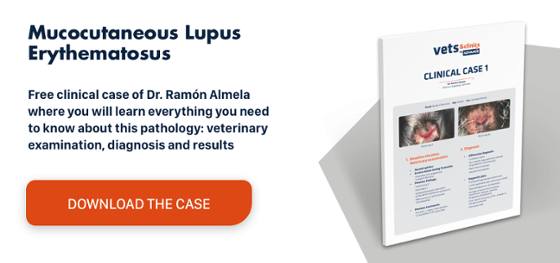Rabies in dogs. What do I need to know?
Rabies in dogs is a viral disease that causes a severe neurological condition that can manifest in two forms: furious or dumb rabies.
Introduction
Rabies is a viral disease that affects the central nervous system of warm-blooded animals, including dogs and humans. It is one of the most important zoonotic diseases given the severity of the resulting clinical picture.
In humans, 99% of cases of rabies are caused by a bite from an infected dog. Half of the world's population lives in endemic areas, and each year the disease kills around 59,000 people, mainly children in rural areas of developing countries in Africa and Asia.1
It is a listed disease in the Terrestrial Animal Health Code of the World Organisation for Animal Health (OIE) and vets must report it to the OIE.
Aetiology
The causative agent of rabies is a linear RNA virus belonging to the genus Lyssavirus within the family Rhabdoviridae. This genus encompasses twelve different species, with classical rabies virus (RABV) the most important in terms of human and animal health.1
Although many mammals can be a host to rabies,2 its main vectors are generally carnivores, often cats and dogs. Other carnivore species or bats can also spread rabies depending on the geographical area. For instance, in Europe, bats and foxes can act as reservoirs of rabies.3
The infection is transmitted through saliva when bitten by an infected animal. Rabies in dogs has an incubation period of up to 2 years, although it is generally 3–8 weeks depending on the inoculation site (the closer the wound is to the CNS, the shorter the incubation) and density of innervation.4
Once infected, the animal may start to excrete viral particles for up to 13 days before the first clinical signs manifest and continue during the symptomatic period until its death.5
Rabies in dogs: clinical picture
Rabies in dogs usually has a clinical course of 5–7 days.It begins with the prodromal phase lasting 1–2 days that often goes unnoticed and which is characterised by sudden behavioural changes. This stage is followed by a symptomatic phase, typically 2–3 days, but which can last up to 5 days.5
After the prodromal phase, the infection manifests in two forms: furious or dumb rabies. Some animals may alternate between the two forms, and, after the onset of clinical signs, the disease is almost always fatal. Death usually occurs 3–7 days after the end of the prodromal phase.
In furious rabies, dogs are restless, they have dilated pupils, a loss of corneal reflex, they remain alert, produce husky howls and are insensitive to pain. They may also be photophobic and hydrophobic, lunge at imaginary objects and bite aggressively at anything they encounter, so they often have cuts and wounds on the muzzle and gums. Their appetite becomes distorted and rabid dogs may ingest stones or soil, among other things. Within 1–4 days, this symptomatology is replaced by progressive ataxia, seizures and ascending paralysis.4,5
In dumb rabies, infected dogs remain still and only bite when provoked. They may tend to hide and display the alert look of the furious form. Patients develop muscle paralysis and tremors, while a characteristic late sign is paralysis of the jaw and tongue, which hangs out of the mouth. There is hypersalivation and rabid dogs cannot eat or drink. The paralysis progresses leading to death a few days later, usually due to paralysis of the respiratory muscles.4,5
Prevention and current situation in Spain
The main prevention strategy for rabies in dogs is vaccination campaigns. It is estimated that if 70% of the dog population can be vaccinated in endemic countries, it could eradicate canine rabies and, therefore, human cases.1
Thanks to vaccination campaigns carried out in cats and dogs, the disease has been eradicated throughout Spain, which has been free of terrestrial rabies since 1978,5 with the exception of one case of rabies imported from Morocco in June 2013 and another in 2019 in a man bitten by an infected cat while visiting the same country. Only Ceuta and Melilla sporadically release reports of imported cases of rabies in dogs and horses. However, given the geographical proximity to endemic countries in North Africa (Morocco, Algeria and Tunisia), the occurrence of rabies on Spanish territory cannot be ruled out.3
In Spain, each Autonomous Community is governed by its own regulations that determine the vaccination requirements for animals registered in the community and animals in transit.3 Rabies vaccination is compulsory throughout Spain, apart from in Galicia, Catalonia and the Basque Country where it is voluntary, and in Asturias, where it is only compulsory for “potentially dangerous” dogs.
Conclusions
Rabies is a zoonotic disease with a worldwide distribution. It is a serious public health concern due to the severity of its clinical picture which is fatal if left untreated. The main vectors of rabies are dogs, in whom the disease can manifest in two forms: furious and dumb rabies. The main means of prevention is vaccination of the dog population.

